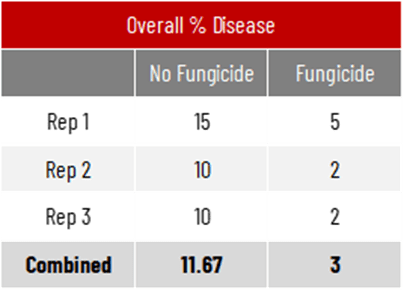2023 PAR (Product & Agronomy Research) Report: Foliar Fungicide Use for Increased Silage Yield and Quality
BY Dairyland Seed Agronomy Team
Description:
This is the third and final year of our investigation of applying fungicide for corn silage production. For two years, we used a mix of dual purpose, HiDF and BMR hybrids. For 2023, we focused on a Bovalta™ BMR corn silage hybrid. We collected silage yield via hand harvest. In addition, we sent samples to the lab for feed quality data.
TREATMENTS:
2021:
- BMR-3508RA™ + Fungicide
- BMR-3508RA™ w/o Fungicide
- HiDF-4999Q™ + Fungicide
- HiDF-4999Q™ w/o Fungicide
- DS-5279Q™ + Fungicide
- DS-5279Q™ w/o Fungicide
2022:
- DB-5211AMXT™ + Fungicide
- DB-5211AMXT™ w/oFungicide
- HiDF-5000Q™ + Fungicide
- HiDF-5000Q™ w/o Fungicide
- DS-5279Q™ + Fungicide
- DS-5279Q™ w/o Fungicide
2023:
- DB-5005Q™ + Aproach® Prima
- DB-5005Q™ w/o Fungicide
RESULTS:
Tables 1 and 2: 2021 Silage Corn Fungicide Trial


Table 3: 2022 Wabash, IN PAR Trials

Table 4: 2023 Wabash, IN PAR Trials

Table 5: 2023 Wabash, IN PAR Trials, Overall Disease Percentage

Table 6: Three Year Average with 21 Combined Replications Over Various Hybrids and Years

RESULTS:
Limited disease levels in all three years at the Wabash, IN site may have reduced the impact of fungicide applications.
In 2021, disease ratings were taken and reported. In 2022, disease ratings were taken; however, little to no disease was present at the late August rating date. For the 2023 season, we used a combined rating for disease, which was still relatively low. Each season, we assessed gray leaf spot, northern corn leaf blight and tar spot. It is typical to see tar spot increase in mid-to-late September at this location. However, for this study, silage harvest is usually completed by this time frame.
In 2021, we observed increased tonnage of about 1,400 lbs. (0.7 tons), and in 2022, it was slightly less at 1,000 lbs. (0.5 tons). In 2023, we noted a considerable increase in silage tonnage to well over three tons. This makes three-year data with over 21 replications show roughly a 1.5 ton/A advantage for using fungicide.
Starch data for all years showed mixed results. The ‘average by year’ numbers may have skewed the information to show decreased starch. However, more data points in previous years may indicate limited-to-no-effect on starch. The NDFD30 numbers showed an increase for two years. However, for 2022, the difference was not as great as in 2021, with a 0.89 increase in NDFD30. In 2023, there was a slight decrease in NDFD30.
CONCLUSION:
Even under little-to-no disease pressure, we record an advantage to applying fungicide for corn silage production. Our multi-year observations show enough yield enhancement to have a positive ROI for the use of fungicide. ven with a decreased silage quality for 2023, we feel there is still a “feed hygiene” advantage and most likely improved NDFD30 starch values.

Brian Weller
Western Region
507.456.3034

Rod Moran
Western Region
507.456.3034

Dan Ritter
Central Region
219.863.0583

Branden Furseth
Northern Region
608.513.4265

Mark Gibson
Eastern Region
260.330.8968

Amanda Goffnett
Eastern Region
989.400.3793

Ryan Mueller
Eastern Region
989.400.3793
